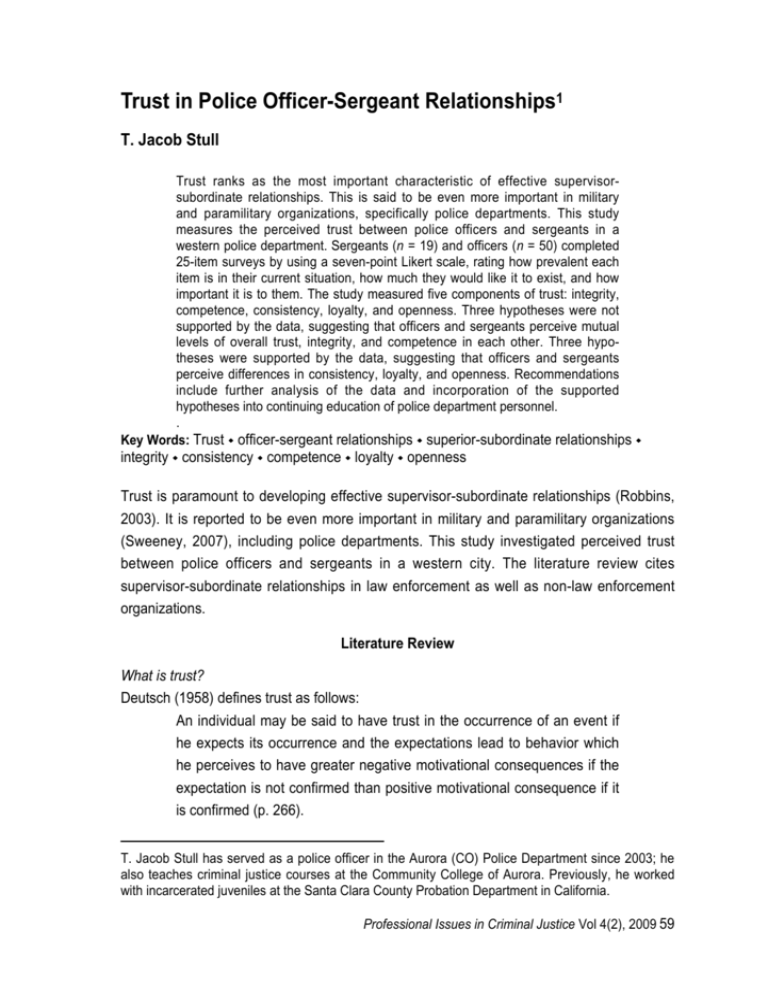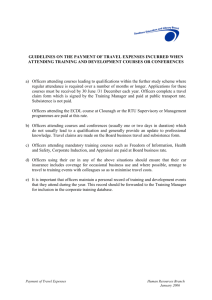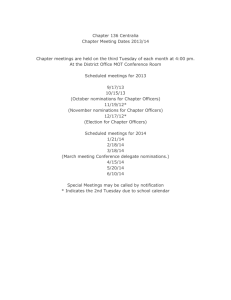
Trust in Police Officer-Sergeant Relationships1
T. Jacob Stull
Trust ranks as the most important characteristic of effective supervisorsubordinate relationships. This is said to be even more important in military
and paramilitary organizations, specifically police departments. This study
measures the perceived trust between police officers and sergeants in a
western police department. Sergeants (n = 19) and officers (n = 50) completed
25-item surveys by using a seven-point Likert scale, rating how prevalent each
item is in their current situation, how much they would like it to exist, and how
important it is to them. The study measured five components of trust: integrity,
competence, consistency, loyalty, and openness. Three hypotheses were not
supported by the data, suggesting that officers and sergeants perceive mutual
levels of overall trust, integrity, and competence in each other. Three hypotheses were supported by the data, suggesting that officers and sergeants
perceive differences in consistency, loyalty, and openness. Recommendations
include further analysis of the data and incorporation of the supported
hypotheses into continuing education of police department personnel.
.
Key Words: Trust ! officer-sergeant relationships ! superior-subordinate relationships !
integrity ! consistency ! competence ! loyalty ! openness
Trust is paramount to developing effective supervisor-subordinate relationships (Robbins,
2003). It is reported to be even more important in military and paramilitary organizations
(Sweeney, 2007), including police departments. This study investigated perceived trust
between police officers and sergeants in a western city. The literature review cites
supervisor-subordinate relationships in law enforcement as well as non-law enforcement
organizations.
Literature Review
What is trust?
Deutsch (1958) defines trust as follows:
An individual may be said to have trust in the occurrence of an event if
he expects its occurrence and the expectations lead to behavior which
he perceives to have greater negative motivational consequences if the
expectation is not confirmed than positive motivational consequence if it
is confirmed (p. 266).
T. Jacob Stull has served as a police officer in the Aurora (CO) Police Department since 2003; he
also teaches criminal justice courses at the Community College of Aurora. Previously, he worked
with incarcerated juveniles at the Santa Clara County Probation Department in California.
Professional Issues in Criminal Justice Vol 4(2), 2009 59
Stull
Boon and Holmes (1991) simplify that definition and define trust as having a positive
expectation that another person won’t act opportunistically or take advantage of you.
How do people communicate to gain trust? What behavior leads to the development
of trust? Schindler and Thomas (1993) identify five components of trust, which this study
uses. They state that for persons to instill a sense of trust in others, they must
demonstrate integrity, competence, consistency, loyalty, and openness.
Integrity. Integrity means honesty and truthfulness. It is likely the most important
dimension to someone who is deciding whether to trust another (Tan & Tan, 2000). Butler
and Cantrell (1984) state, "without a perception of the other's 'moral character' and 'basic
honesty,' other dimensions of trust were meaningless" (p. 20). Kouzes and Posner (1993)
state, “Honesty is absolutely essential to leadership. If people are going to follow
someone willingly, whether it be into battle or into the boardroom, they first want to assure
themselves that the person is worthy of their trust” (p. 14).
Competence. Competence refers to a leader’s technical and interpersonal knowledge and
skills. Hogan and Warrenfeltz (2003) identify four broad categories of leader competencies:
intrapersonal skills, interpersonal skills, business skills, and leadership skills. Sweeney
(2007) further defines these qualities. Intrapersonal skills include maintaining composure and
self-control and managing stress. Interpersonal skills are the ability to build and maintain
relationships; make a personal connection with others; and make an effort to learn about
others, listen to their concerns, and understand their basic needs. Business skills are
planning, budgeting, coordinating, and monitoring abilities. Some might equate business
skills with a strong sense of duty, doing the right thing, and getting the job done.
Leadership skills include building and guiding a high-performance team, confidence, and
physical and moral courage.
Consistency. A trustworthy individual is reliable, is predictable, and uses good judgment in
any situation. Such an individual elicits what researchers call knowledge-based trust
(Lewicki & Bunker, 1996). Blanchard (2007) explains that trust occurs when leaders
behave consistently with the values they profess. Leaders communicate their values and
the organization’s values to their team and then integrate those values into how the team
operates. They also recognize and reward those who embody these values.
Loyalty. Loyalty is one’s allegiance to others and willingness to protect them from
unnecessary danger or undue criticism. If you trust that someone has your best interests
in mind, you believe that person is loyal to you. When officers trust their sergeants, they
are willing to be vulnerable to the sergeant’s actions, believing the sergeant will protect
60 Professional Issues in Criminal Justice Vol 4(2), 2009
Trust in Police Officer-Sergeant Relationships
their rights and interests (Hosmer, 1995). For example, a sergeant who accepts the blame
for something an officer did incorrectly because of faulty directions from the sergeant
shows loyalty to the officer. Bolman & Deal (2006) state that leaders must defend the
group and its way of life. The trust they engender as a result of their defense of the group
is identification-based trust (Lewicki & Bunker, 1996).
Openness. Openness is providing someone with the full truth—sharing information openly
(Blanchard, 2007). In a study of 12 manufacturing organizations, Stull (1978) found that
supervisors and subordinates preferred a communication climate characterized by
perceived openness to sending and receiving messages about task and non-task issues.
Schindler and Thomas (1993) created directional hypotheses regarding which
components are most important to supervisors, subordinates, and peers. They based their
predictions on the work of Schmidt & Posner (1982), which analyzed the qualities most
admired in supervisors, subordinates, and peers. Schindler & Thomas’ study concluded
that whether the relationship was with a supervisor, a subordinate, or a peer, each person
identified the order of importance of the components of trust, from most to least, as
integrity, competence, loyalty, consistency, and openness.
Methods
This study used the following methodology to measure the perceived trust between
sergeants and police officers in the police department of a western city:
Subjects. The subjects in this study were sergeants (n = 19) and police officers (n = 50).
Variables. The independent variable was position—sergeant or officer. The dependent
variable was perceived trust.
Hypotheses. This study tested six hypotheses. Deferring Schindler and Thomas’ (1993)
hypotheses for future analysis, the researcher created the following a priori, nondirectional hypotheses for this study:
H1 There will be differences in the reported mean scores of sergeants and officers
regarding how much they trust each other.
H2 There will be differences in the reported mean scores of sergeants and officers
regarding how much integrity they observe in each other.
H3 There will be differences in the reported mean scores of sergeants and officers
regarding the competence level they observe in each other.
Professional Issues in Criminal Justice Vol 4(2), 2009 61
Stull
H4 There will be differences in the reported mean scores of sergeants and officers
regarding how much consistency they observe in each other’s performance.
H5 There will be differences in the reported mean scores of sergeants and officers
regarding how much loyalty they perceive from each other.
H6 There will be differences in the reported mean scores of sergeants and officers
regarding how open they are with each other.
The null hypotheses are that there would be no differences between sergeants’ and
officers’ perceptions.
Research Instruments
Two research instruments were created for this study, one tailored to sergeants and one
to officers. Each comprised 25 items rated on a seven-point Likert-type scale along three
dimensions: how often that behavior occurred between the sergeant and officer, how
often the respondent wished it occurred, and how important the behavior was to the
respondent (Porter, 1961). Five items were included to measure each component of trust;
four were loaded positively, and one was loaded negatively for each item. The purpose of
the negative loading was to determine whether respondents discriminated among items.
A sample openness item from the sergeant survey follows:
I am willing to listen to concerns about personal matters from my officers.
1. This how it is with my officers.
2. This is how I wish it were with my officers.
3. This is very important to me.
A sample loyalty item from the officer survey is:
My sergeant admits if he has done something wrong that has led to an officer making
a mistake.
1. This is how it currently is with my sergeant.
2. This is how I wish it were with my sergeant.
3. This is very important to me.
Peers and teachers validated the surveys for content and grammatical correctness.
They agreed that the purpose was to measure leadership.
Procedures
This study used 2 x 3 x 5 quasi-experimental research design. The researcher secured
the appropriate protocol documents from the university and police department institutional
62 Professional Issues in Criminal Justice Vol 4(2), 2009
Trust in Police Officer-Sergeant Relationships
research boards. Participants were provided with an informed consent document, the
appropriate survey, and response sheets; they were asked to complete the survey and
return it to the researcher. A convenience sample was accepted in place of a random
sample because of the nature of police work and the ability to recruit willing participants.
The data were subjected to SPSS t-tests to determine whether the mean scores
between supervisors and subordinates were significantly different. Tests were applied to
all six hypotheses, measures of desired trust, and measures of importance. Additional tests
were used to compare existing with desired levels of overall trust. The researcher conducted a
final test to determine whether participants discriminated between positively and negatively
loaded survey items. Hypotheses were considered supported at the .05 level or lower.
Results
Comparisons of means for perceived overall trust, integrity, and competence indicated
differences between sergeants and officers (Table 1); however, these data do not support
rejecting the null hypotheses that there would not be statistically significant differences in
the reported mean scores. The differences between the means on consistency, loyalty,
and openness were statistically significant and supported rejecting the null hypotheses.
Table 1. Mean Scores for Perceptions of Sergeant-Officer Trust
Rank
Variable
All
Integrity
Competence
Consistency
Loyalty
Openness
Officers
Sergeants
t
p
5.6427
5.4333
1.062
.292
(48)
(18)
5.6071
5.2632
1.583
.118
(49)
(19)
5.9082
5.8816
.110
.913
(49)
(19)
5.8571
5.3421
2.856
.005
(49)
(19)
5.5000
6.2368
3.142
.003
(49)
(19)
5.4167
4.3750
4.178
.000
(48)
(18)
Note. The numbers in parentheses indicate the number of subjects (n) who responded to the
respective items. Numbers differ within sample groups because some subjects inadvertently did
not respond to every item.
Professional Issues in Criminal Justice Vol 4(2), 2009 63
Stull
Comparisons of means for desired levels of overall trust, integrity, competence,
consistency, and openness indicated differences between sergeants and officers (Table
2); however, these differences were not significant. The difference between means on
desired loyalty was statistically significant.
Table 2. Mean Scores for Perceptions of Sergeant-Officer Desired Levels of Trust
Rank
Variable
All
Integrity
Competence
Consistency
Loyalty
Openness
Officers
Sergeants
t
p
5.3052
5.2474
.852
.188
(48)
(19)
5.2245
5.2763
.873
.161
(49)
(19)
5.4949
5.6974
.586
.547
(49)
(19)
5.3469
4.8816
.177
1.365
(49)
(19)
4.6429
5.6974
3.780
.000
(49)
(19)
4.9479
4.6842
.896
.374
(48)
(19)
Note. The numbers in parentheses indicate the number of subjects (n) who responded to the
respective items. Numbers differ within sample groups because some subjects inadvertently did
not respond to every item.
Comparisons of scores on the importance of overall trust, integrity, competence,
consistency, loyalty, and openness indicated differences between sergeants and officers
(Table 3); however, the means were not statistically significant.
A further analysis confirmed that respondents discriminated among positively and
negatively loaded items on the surveys (p < .001).
Discussion
This study provided no statistically significant support for three hypotheses related to trust
between leaders and followers: perceptions of overall trust, integrity, and competence; however,
it did provide statistically significant support related to three hypotheses: perceptions of
consistency, loyalty, and openness.
64 Professional Issues in Criminal Justice Vol 4(2), 2009
Trust in Police Officer-Sergeant Relationships
Table 3. Mean Scores for Perceptions of Importance of Sergeant-Officer Trust
Rank
Variable
All
Integrity
Competence
Consistency
Loyalty
Openness
Officers
Sergeants
t
p
5.9010
5.9030
.015
.988
(49)
(19)
5.6633
5.9342
1.462
.149
(49)
(19)
6.1888
6.3158
.775
.441
(49)
(19)
6.0561
5.7237
1.686
.097
(49)
(19)
6.3112
6.4211
.726
.471
(49)
(19)
5.2857
5.3158
.145
.885
(49)
(19)
Note. The numbers in parentheses indicate the number of subjects (n) who responded to the
respective items. Numbers differ within sample groups because some subjects inadvertently did
not respond to every item.
Officers perceived sergeants as more consistent than sergeants perceived officers
(p < .01). Sergeants perceived officers as more loyal than officers perceived sergeants
(p < .01). Sergeants also expressed the wish that their officers were more loyal more often
than officers expressed the same wish about their sergeants (p < .001). Officers perceived
sergeants as more open than sergeants perceived officers (p < .001).
Schindler and Thomas (1993) found no differences between supervisor-subordinate
pairs on the importance of integrity, competence, loyalty, consistency, or openness; this
study found similar results. However, while this study used different measurement
instruments, the outcome did not match Schindler and Thomas’ study in terms of order of
importance of the components of trust. Schindler and Thomas found that all groups
ranked the components, in order of most important to least important, as integrity,
competence, loyalty, consistency, and openness. In this study, the order was loyalty,
competence, integrity, consistency, and openness for sergeants; for officers, it was
loyalty, competence, consistency, integrity, and openness. These differences could be
due to the nature of police versus business responsibilities. It can also be attributed to the
different methodologies these studies employed. This study also came to different
conclusions regarding the order of importance of components than studies by Butler &
Cantrell (1984) and Schmidt & Posner (1982). Butler and Cantrell argue that loyalty is
Professional Issues in Criminal Justice Vol 4(2), 2009 65
Stull
more important for trust in supervisors than for trust in subordinates. Schmidt and Posner
argue that loyalty is most important for trust in subordinates and less important for trust in
supervisors. This study ranked loyalty as most important for both groups.
Applications of the Study
The results of this and similar studies can be applied to training programs, emphasizing
the importance of establishing trust between officers and sergeants and providing
suggestions for how to develop such trust. Consultants might help to uncover reasons for
differences in perceptions of trust and ways to deal with them. Some of the findings may
merely emphasize what might be expected behavior in organizational culture.
Consistency. From leader-member exchange theory, we are reminded that, inadvertently,
leaders often create in-groups and out-groups. This leads to a lack of consistency in how
people are treated. Leadership training should highlight this tendency and caution leaders
about the consequences of this occurrence. Sergeants actually scored lower on the
consistency measure than officers, suggesting they see officers as less consistent. While
most of the items’ mean scores were in the 5 and 6 ranges, one item’s mean score was
4.1579: item 28 asked sergeants whether officers follow the book when handling
situations. This particular item may have received this lower score not so much because
sergeant don’t trust their officers to follow the book, but because sergeants realize from
their own experience that different situations may lead to different interpretations of “the
book.” Another possible reason for this lower mean score could be that sergeants oversee
numerous officers, and they may take into account isolated incidents of inconsistent
behavior. One sergeant actually reported to the researcher, “I trust my officers until they
[screw] up, then I don’t trust them anymore.” This statement offers an example of
deterrence-based trust, where one violation or inconsistency can destroy the relationship
(Lewicki & Bunker, 1996).
Loyalty. How do sergeants show the same loyalty to their officers that they show to their
own superiors? How do officers react when they know their sergeants’ loyalty is directed
upward in the organization? Sergeants actually scored officers as more loyal than officers
scored sergeants. Officers’ mean scores for every positively loaded item were in the 5
range; the lowest was 5.2041 for an item that read “My supervisor motivates me to
achieve and grow within the department.” While this result is still positive, perhaps this is
an area on which leadership training for sergeants could focus. Transformational leadership might work best in this situation, with sergeants inspiring officers to maximize their
potential and improve, and superiors promoting within the department. Leadership training
66 Professional Issues in Criminal Justice Vol 4(2), 2009
Trust in Police Officer-Sergeant Relationships
should also emphasize the need for sergeants to demonstrate loyalty to officers and,
perhaps, camouflage their loyalty to superiors.
Openness. Does a supervisor really expect officers to be completely open when filing
reports of criminal incidents, particularly if the supervisor served on the streets for some
time? Do officers expect sergeants to be completely open with them about everything?
Some information is confidential, and some is personal. Some sergeants might not want
to talk about personal issues with their officers. In fact, this was the lowest scoring item
from officers about their sergeants. Item 7—“My supervisor talks openly with me about his
personal matters”—had a mean score of 3.8400. Sergeants showed a mean score of
2.5263 on item 4—“I feel free to talk only about task-related matters with my officers.” This
item’s wording was overlooked during preparation of the survey. The word “only” should
not have been included and actually loads the question negatively. Sergeants showed a
mean score of 2.7638 on item 22—“I feel free to talk with my officers about my own
personal matters.” The general literature on openness encourages disclosure of
information, but full disclosure may not be appropriate or comfortable for everyone. The
professional work environment of a specific department may not encourage true
openness between sergeants and officers due to the paramilitary hierarchy. However,
training on how to handle various situations might arm officers and sergeants with
appropriate responses when personal matters arise that still can lead to creating
understanding and a supportive climate for openness.
Raising these topics during training would promote discussion and awareness among
both officers and sergeants regarding issues of trust. For example, asking officers to
define concepts such as consistency, loyalty, and openness during their in-service
workshops then passing this information along to sergeants in leadership training would
be a first step to improving officer-sergeant relationships. Another step would be to clarify
expectations sergeants and officers have of each other and to define how to meet those
expectations. Implementing positive change based on this feedback would be the ultimate
goal in improving trust between sergeants and officers. Ongoing monitoring and feedback
on the effectiveness of these efforts would be essential to this process.
Future Research
This study asked sergeants and officers to share their perceptions of each other regarding
trust. Future studies might take on different characteristics. Greguras & Ford (2006)
suggest developing separate measurement criteria for supervisors and subordinates
Professional Issues in Criminal Justice Vol 4(2), 2009 67
Stull
because each group may have differing perceptions of relationships and what is important
in terms of integrity, competence, consistency, loyalty, and openness.
Lewicki, Tomlinson, and Gillespie (2006) point out that most studies measure trust at
a given point in time. During this study, this researcher received comments from several
officers suggesting a negative relationship with their sergeants. A recurring comment was
along the lines of, “You want me to take this survey now? My sergeant is a [jerk].” These
kinds of reactions are frequently temporary until an issue is resolved. Lewicki et al.
suggest longitudinal studies might focus on measuring the development of trust over a
period of time.
Data collection could include open-ended, in-depth responses that might reveal more
than just interval data. Emotions and actual behavior might emerge through this
technique. Interviews and observational studies might lead to more profound results.
An item-by-item analysis could be performed on the frequency distribution, standard
deviations, and variations this study captured. Each item has meaning and could lead to
valuable information. For example, a mean of 5.00 on an item might be the result of most
answers hovering between 4 and 6, or it may be the result of answers scattered all over
the scale. What can be attributed to the reason for a minimum score of 6 and a maximum
score of 7 on supervisor’s item 19—“I always have the best interest of my subordinates in
mind?” Why do subordinates score a minimum of 1 and a maximum of 7 on item 4—“My
supervisor admits when he has done something wrong that has led to a subordinate
making a mistake”? The differences may tell a story.
More discrete items could be created to measure each component of trust. The
instruments could be validated more thoroughly. During the validation process, raters
could assign each item to one of the components of trust and an inter-rater reliability
coefficient calculated to strengthen the integrity of the instruments.
The methodology could be tighter, perhaps executed in concert with other
researchers with more experience and expertise in research methods.
Finally, a broader sample could be studied that includes more officers and sergeants
from a variety of organizations and departments.
The department in this study appears to be healthy in terms of the amount of trust
officers and sergeants report. All the means were on the positive side of the scale, except,
of course, for the negatively loaded ones. Even the differences between means on
consistency, loyalty, and openness were on the positive side.
Trust between sergeants and officers is necessary. The level of trust depends on
personalities, stress levels of the job, organizational politics, and other factors. Expecting
total trust might be too idealistic. However, for teams to perform well, people need to be
able to count on each other. It is particularly important for police officials to work on
68 Professional Issues in Criminal Justice Vol 4(2), 2009
Trust in Police Officer-Sergeant Relationships
developing trust between sergeants and officers in their departments, where the
difference is not measured in profits (as in business organizations) but in people’s lives
and public safety.
Note
1. This article is based on a master’s thesis the researcher completed at Kaplan
University under the supervision of Dr. Cliff Roberson.
References
Blanchard, K. (2007). Leading at a higher level: Blanchard on leadership and creating
high performing organizations. Upper Saddle River, NJ: Prentice Hall.
Bolman, L. G., & Deal, T. E. (2006). The wizard and the warrior: Leading with passion and
power. San Francisco: Jossey-Bass.
Boon, S. D., & Holmes, J. G. (1991). The dynamics of interpersonal trust: Resolving
uncertainty in the face of risk. In R. A. Hinde and J. Groebel (Eds.), Cooperation and
prosocial behavior (pp. 190–211). Cambridge, UK: Cambridge University Press.
Butler, J. K., Jr., & Cantrell, R. S. (1984). A behavioral decision theory approach to modeling
dyadic trust in superiors and subordinates. Psychological Reports, 55, 19–28.
Deutsch, M. (1958). Trust and suspicion. Journal of Conflict Resolution, 2, 265–279.
Greguras, G. J., & Ford, J. M. (2006). An examination of the multidimensionality of
supervisor and subordinate perceptions of leader-member exchange. Journal of
Occupational and Organizational Psychology, 79, 433–465.
Hogan, R., & Warrenfeltz, R. (2003). Educating the modern manager. Academy of
Management Learning and Education, 2, 74–84.
Hosmer, L. T. (1995). Trust: The connecting link between organizational theory and
philosophical ethics. Academy of Management Review, 20, 379–404.
Kouzes, J. M., & Posner, B. Z. (1993). Credibility: How leaders gain and lose it and why
people demand it. San Francisco: Jossey-Bass.
Lewicki, R. J., & Bunker, B. B. (1996). Developing and maintaining trust in work
relationships. In R. J. Kramer & T. Tyler (Eds.), Trust in organizations: Frontiers of
theory and research (pp. 114–139). Thousand Oaks, CA: Sage Publications.
Professional Issues in Criminal Justice Vol 4(2), 2009 69
Stull
Lewicki, R. J., Tomlinson, E. C., & Gillespie, N. (2006). Models of interpersonal trust
development: Theoretical approaches, empirical evidence, and future directions
Journal of Management, 32, 991–1022.
Porter, L.W. (1961). A study of perceived need satisfaction in bottom and middle
management jobs. Journal of Applied Psychology, 45, 1–10.
Robbins, S. P. (2003). Organizational behavior (10th ed.). Upper Saddle River, NJ:
Pearson/Prentice Hall.
Schindler, P. L., & Thomas, C. C. (1993). The structure of interpersonal trust in the
workplace. Psychological Reports, 73, 563–573.
Schmidt, W., H., & Posner, B. Z. (1982). Managerial values and expectations: The silent
power in personal and organizational life. New York: American Management
Association.
Stull, J. B. (1978). Rewards for openness. Journal of Communication, 28, 124–129.
Stull, T. J. (2008) Trust in supervisor-subordinate relationships in a Western police
department: A quasi-experimental field study. Unpublished master’s thesis, Kaplan
University.
Sweeney, P. J. (2007). Trust: The key to combat leadership. In D. Crandall (Ed.),
Leadership lessons from West Point (pp. 252–277). San Francisco: Jossey-Bass.
Tan, H. H., & Tan, C. S. F. (2000). Toward the differentiation of trust in supervisor and
trust in organization. Genetic, Social, and General Psychology Monographs, 126
241–260.
70 Professional Issues in Criminal Justice Vol 4(2), 2009







